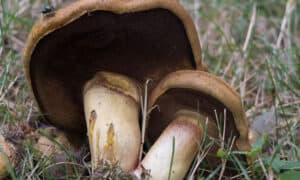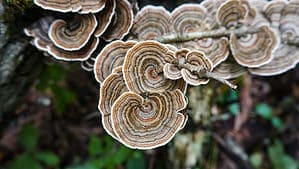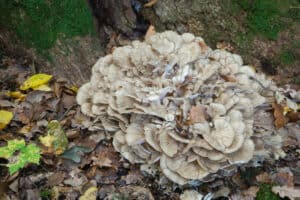Blue-colored mushrooms are a bit of a rare occurrence. This is likely due to mushrooms’ lack of widespread use for this color. While some fungi use animals to spread their spores, these animals don’t typically see blue shades and thus would not be attracted to a blue mushroom. A current theory for the rare presentation of blue pigments in some mushrooms, such as azulene, is that these pigments may have antiherbivore properties.
While blue mushrooms are currently underrepresented in fungi, there are some striking examples you may come across in woodlands, meadows, gardens, and along roadsides. In this guide, we’ll cover five types of blue mushrooms, describe their native range, how to identify them, and what their edibility status is.
Read on to learn more!
1. Types of Blue Mushrooms: Blue Roundhead (Stropharia caerulea)
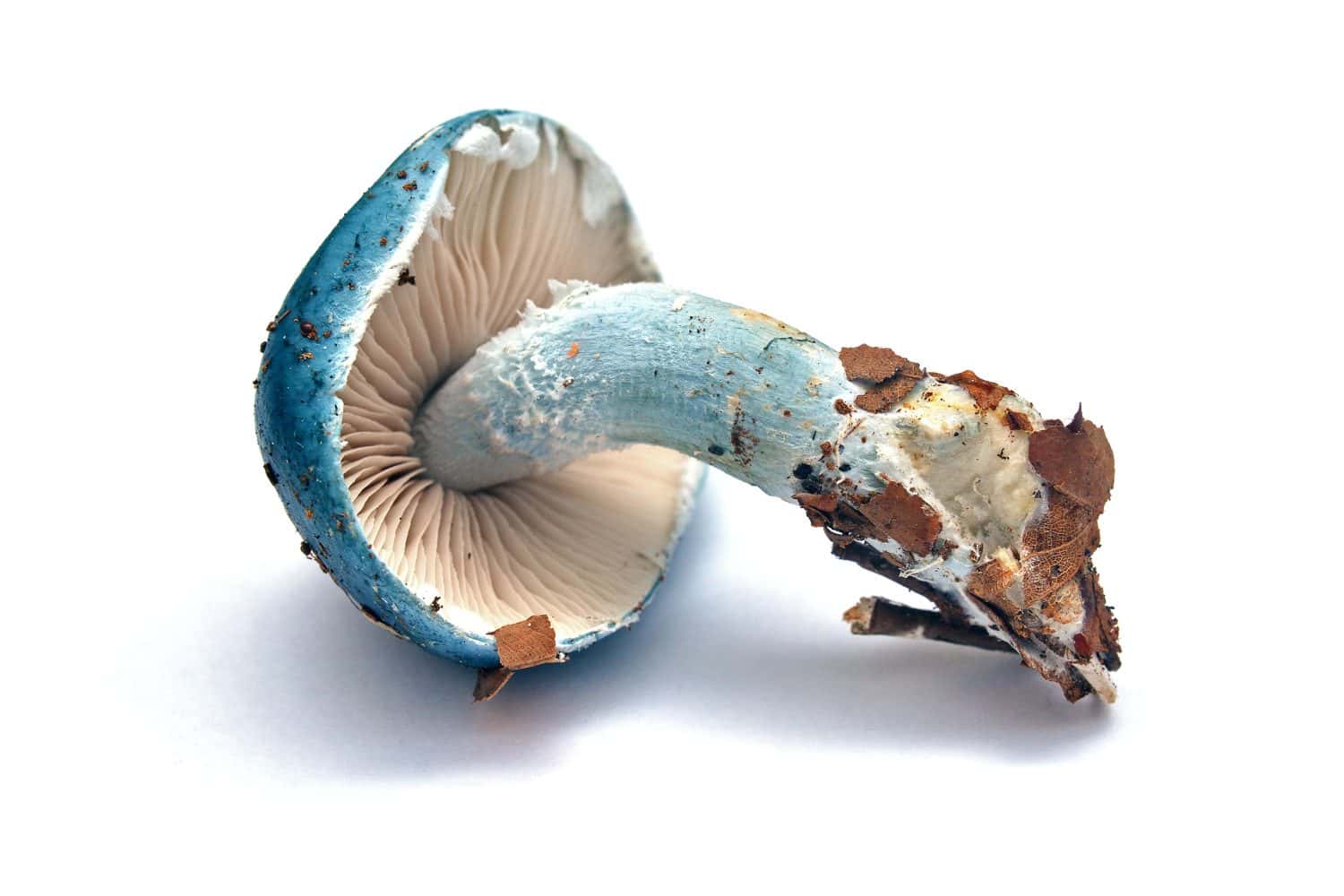
Some sources list the blue roundhead mushroom as psychoactive, but that has not been confirmed.
©bogdan ionescu/Shutterstock.com
A stunningly blue-green specimen, the blue roundhead (Stropharia caerulea) is a delightful mushroom commonly occurring across temperate regions of Europe and North America.
Identification
Note that for field identification, when young, the blue roundhead is difficult to distinguish from young specimens of its close relative, the blue-green stropharia (Stropharia aeruginosa). As the mushrooms age, the blue roundhead retains much more blue-green coloration, while S. aeruginosa often fades to a pale yellowish brown.
Cap
Initially bell-shaped, the vividly blue-green cap becomes broadly bell-shaped or convex as it matures. Fresh specimens typically feature a distinctly slimy cap. The cap may fade to yellowish green or develop yellowish spots as it ages. Partial veil remnants often hang off the margin of young specimens.
A partial veil is a thin membranous tissue covering and protecting immature specimens’ gills. As it ages and the cap expands, the partial veil breaks, often leaving a ring (annulus) around the upper stem (stipe) and sometimes veil remnants around the cap margin. At maturity, the cap may measure up to 1.5 inches across. The flesh of the cap is white and does not change colors when sliced or bruised.
Gills
When young, the gills are whitish in coloration. As they age, the maturing spores turn the gills purplish gray to purplish brown. The spore print is purplish brown.
Stipe
The stipe measures up to 2 inches tall and tapers slightly outward at the base. A faint partial veil ring is often present around the upper stipe, and young specimens may have a faintly white, shaggy appearance. When fresh, the stipe is tacky. Young specimens feature blue-green stripes that tend to fade in vividness with age. The flesh of the stipe is white or sometimes bluish-green toward the base.
Ecology
Throughout North America, the blue roundhead primarily occurs in gardens, mulched areas, meadows, pastures, and along roadsides. It is a saprobic species, meaning the fungus obtains its nutrients from dead, decaying organic matter. In the case of Stropharia caerulea, it gets nutrients primarily from decaying grass thatch, mulch, and leaf litter.
Edibility
Most field guides regard Stropharia caerulea as inedible and likely to cause gastrointestinal upset upon consumption.
2. Indigo Milk Cap (Lactarius indigo)
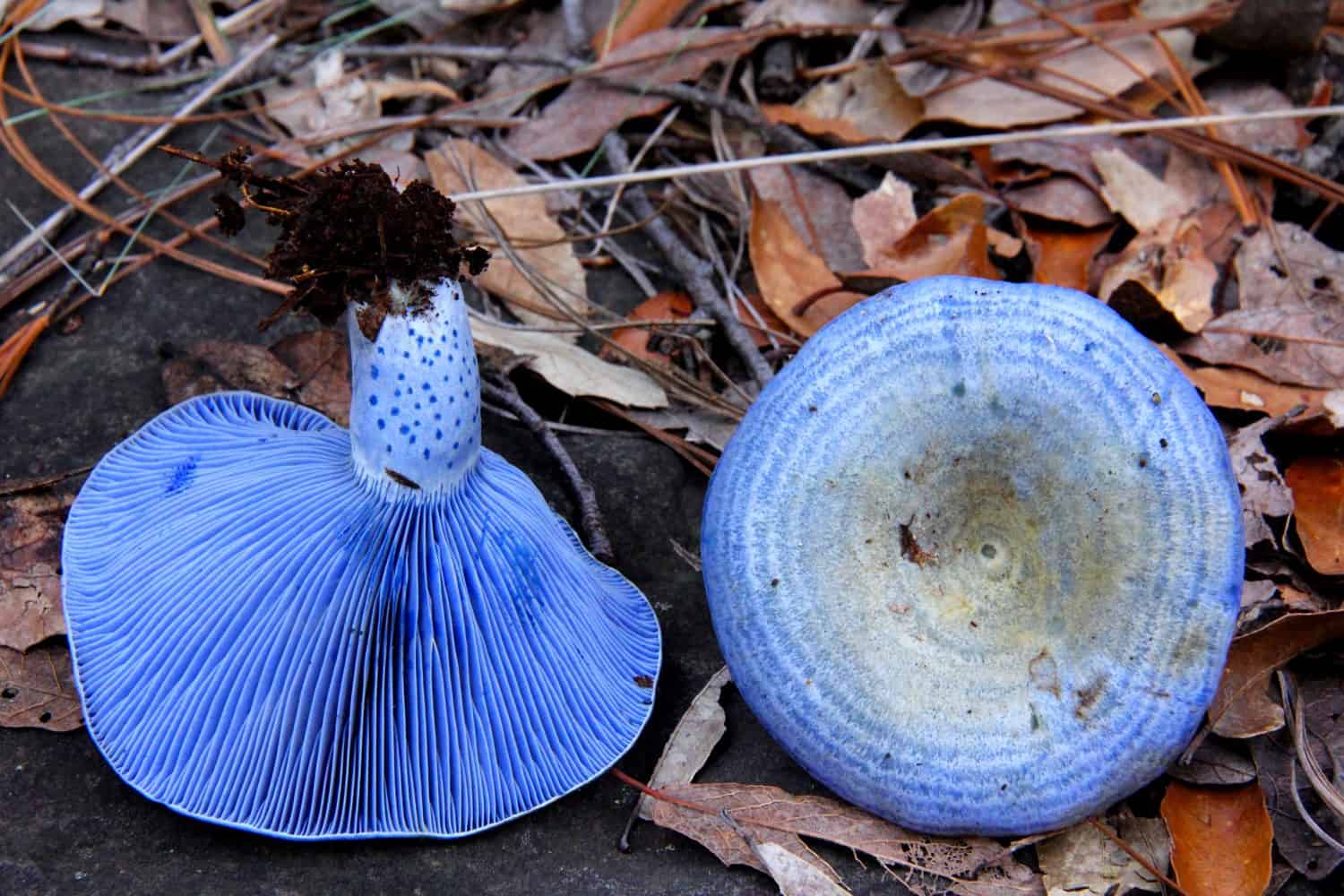
There are some lookalikes to the indigo milk cap, but they do not have strikingly blue gills and will not bleed blue latex.
©Gajda/Shutterstock.com
A strikingly beautiful and highly sought-after mushroom, the indigo milk cap (Lactarius indigo) is an absolute gem of a blue-colored mushroom. This mushroom is widespread across eastern and southwestern North America, East Asia, and Central America.
Identification
Some mycologists believe the indigo milk cap may be a species complex in which multiple, yet-to-be-determined, nearly identical-appearing species exist under the Lactarius indigo name.
Cap
The indigo milk cap may reach up to 6 inches across at maturity. When young, the cap is convex with a central depression and rolled in margins. As it matures, the cap becomes flat or broadly vase-shaped. The indigo-blue coloration of the cap appears evenly across or in concentric zones that tend to fade with age. When bruised, the cap turns a deep green color. The flesh is whitish and stains indigo when bruised or cut before slowly turning blue-green.
Gills
The gills of Lactarius indigo are the most vividly blue. Young specimens, in particular, feature a striking, deep blue-indigo coloration. The gills are closely arranged and subdecurrent, meaning they begin to run down the stipe. When the gills are pressed or cut, they produce a gorgeous blue milky latex, which turns dark green when exposed to oxygen. This milk-like (latex) substance gives the Lactarius mushrooms their genus name. The spore print is a yellowish-cream color.
Stipe
The stipe measures about 3 inches tall with slight tapering toward the base. You may observe the stipe either center or slightly off-center of the cap. You will usually see what looks to be “potholes” on the stem, which is not a feature you’ll typically see in many mushroom species outside of Lactarius/Lactifluus.
Ecology
The indigo milk cap is mycorrhizal, meaning the underground, branching, and filamentous structure (mycelium) of Lactarius indigo engages in a mutually beneficial nutrient exchange with the roots of plants. In this exchange, the mycelium scavenges the soil for nutrients, such as phosphorus and nitrogen, to bring to the plant’s roots, while the plant root provides the mycelium with carbon and sugars. Specifically, Lactarius indigo is mycorrhizal with oak and pine trees. This mushroom may grow alone, scattered, or abundantly in the summer and fall near its mycorrhizal tree partners.
Edibility
Lactarius indigo is edible and commonly sold in rural markets in China, Guatemala, and Mexico. Most folks consider the mild, portobello-like flavor second to the marvelous color and joy of foraging such a beautiful wild mushroom. Many people who eat them prefer them when they are younger as the texture is less gritty.
3. Types of Blue Mushrooms: Pixie’s Parasol (Mycena interrupta)
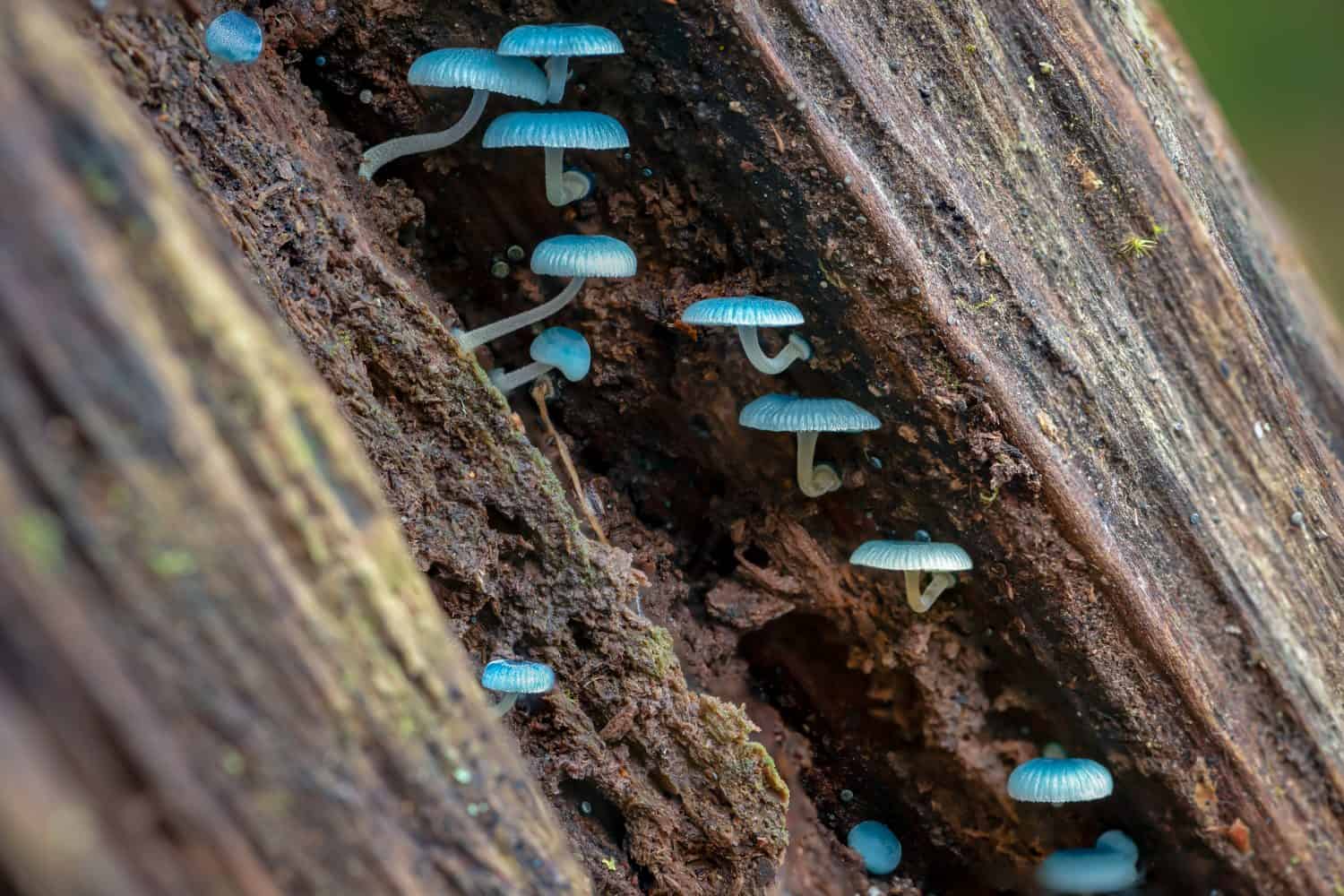
Pixie’s parasol mushrooms are extremely photogenic with their vividly blue coloration.
©james_stone76/Shutterstock.com
In southeast Australia, New Zealand, New Caledonia, and Chile, the pixie’s parasol is a lovely and fragile blue mycena mushroom. This mushroom is quite popular with photographers, given its charismatic coloration and whimsical morphology.
Identification
This mushroom thrives in tropical, wet ecosystems. While they appear striking during the day, they aren’t bioluminescent at night like some other species in the Mycena genus.
Cap
The cap of these tiny mushrooms can measure up to 3/4th of an inch across. Featuring a vivid cyan-blue color, these brilliant little mycenas caps are hard to miss during a woodland stroll. Initially spherical, the cap becomes broadly convex as the mushroom matures. The center of the cap is slightly depressed, and the fruiting body is sticky (viscid) when fresh. The margin of the cap typically fades in color as it matures, while the center remains vividly cyan blue. The margin features striations.
Stipe
The thin, fragile stipe is white to whitish pale blue. It measures up to an inch tall and only about .075 inches thick. The stipe is smooth and does not feature a partial veil ring.
Gills
The gills of Mycena interrupta are white with ghostly blue margins and are narrowly to freely attached to the stipe. They are close to distantly arranged. The spore print is white.
Ecology
Pixie’s parasol grows in closely arranged clusters on moist, rotting wood in extremely moist forest environments. They primarily occur in beech or eucalyptus-abundant rainforests. These mushrooms are saprobic and derive their nutrients from the rotting wood upon which they grow.
Edibility
Field guides do not recommend ingesting mushrooms in the Mycena genus, as many are poisonous and difficult to distinguish from one another.
4. Types of Blue Mushrooms: Blue Oyster Mushroom (Pleurotus columbinus)
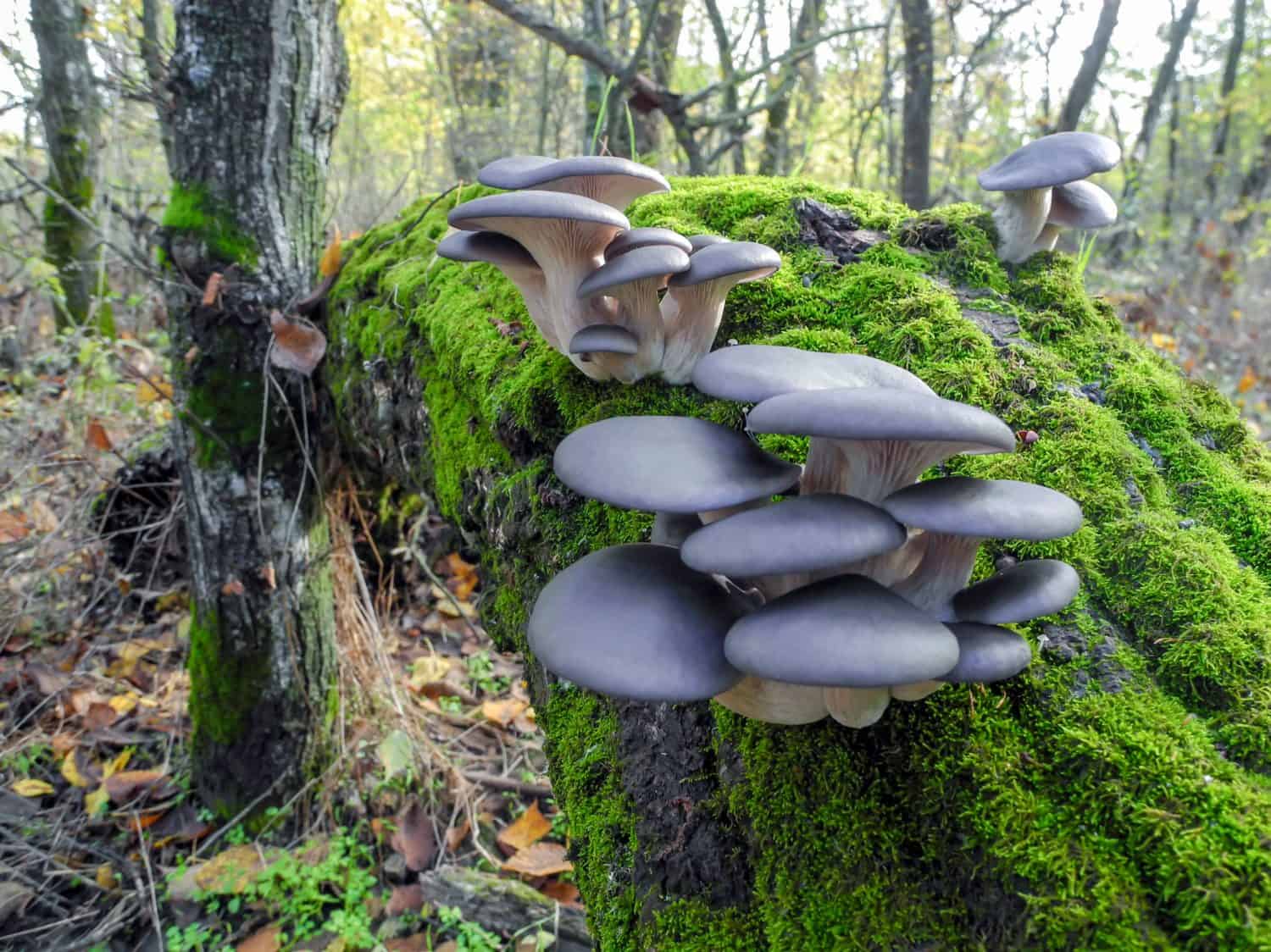
While normally cultivated, blue oyster mushrooms also occur in the wild.
©LeManilo/Shutterstock.com
The only cultivated blue-colored mushroom on our list is the blue oyster mushroom (Pleurotus columbinus). These cool-loving mushrooms are cultivated worldwide and occur naturally in temperate forests globally, especially across North America, Asia, and Europe.
Identification
With stunning and smoky blue-grey caps, these mushrooms are a delight to forage and cultivate. Note that this mushroom is also sometimes called Pleurotus ostreatus var. columbinus.
Cap
The cap of the blue oyster can reach up to about 11 inches across when fully mature. Young specimens have particularly dark blue caps. As they age, the caps tend to fade to a blue-grey color. When cultivating, increased light during fruiting tends to result in a bluer-colored cap. When young, the cap is rolled in at the margin and convex. As it matures, the cap expands to broadly convex or flat.
Gills
The gills of Pleurotus columbinus are white to whitish gray at maturity. They run decurrently down the stocky stipe. The spore sprint is typically an off-white to lilac-gray color.
Stipe
The stipe of the blue oyster mushroom is robust and stocky. The width of the stipe expands toward the cap. The white coloration of the stipe and gills contrasts beautifully with the blue-colored caps. As with many cultivated mushrooms, growing conditions can affect the general look of the mushrooms. They can be lankier in stature if they have to reach for fresh air.
Ecology
Pleurotus columbinus is saprobic and fruits on fallen hardwood logs and stumps. They typically fruit in the spring and autumn when temperatures are between 55 and 75 degrees Fahrenheit.
Edibility
Blue oyster mushrooms are edible and highly prized for their savory flavor and meaty, chewy texture. These robust mushrooms are well-suited to various preparations and are often used in seafood-inspired dishes.
5. Types of Blue Mushrooms: Blue-Green Elfcup (Chlorociboria aeruginascens)
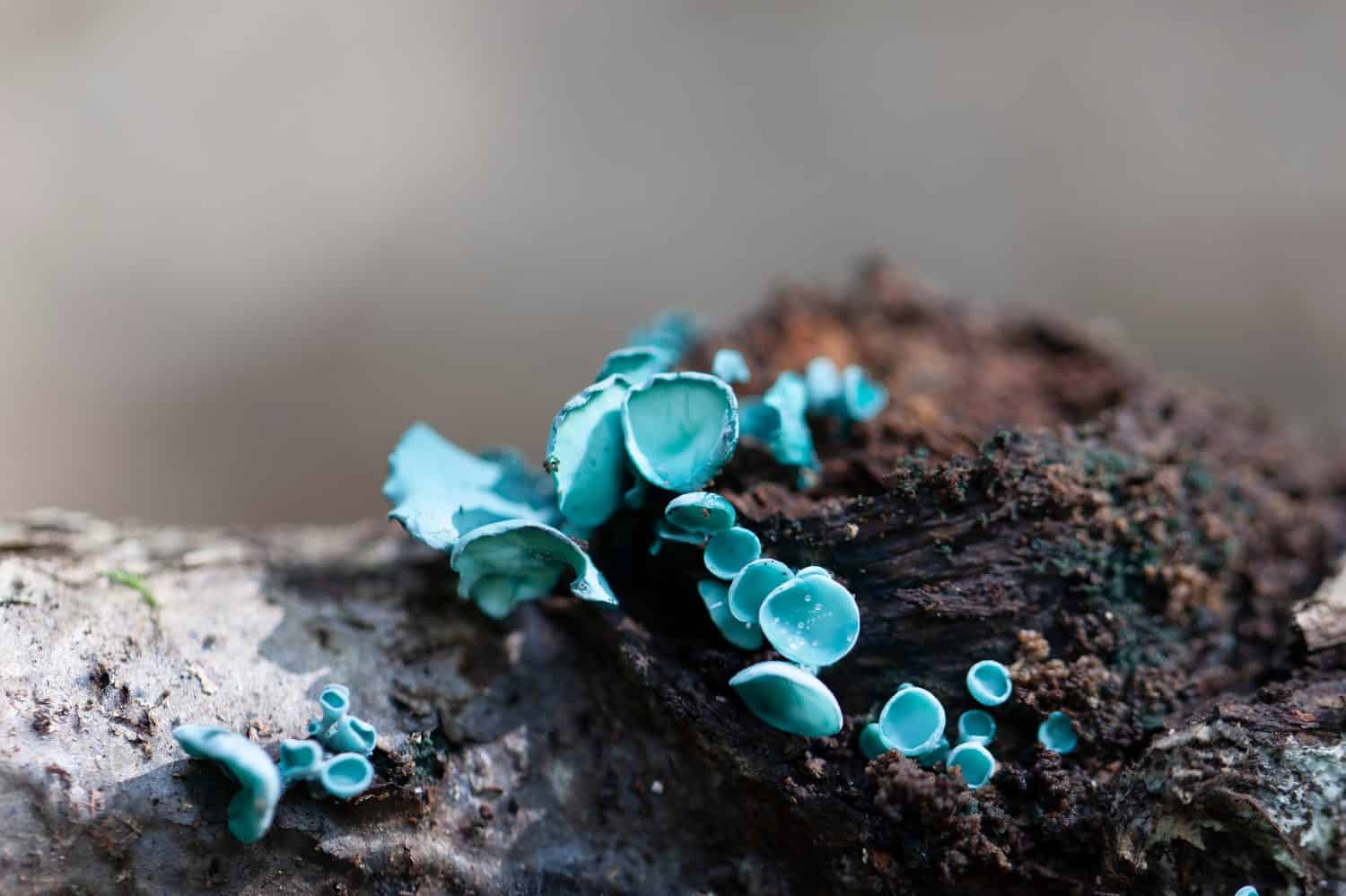
This gorgeous blue mushroom is more closely related to truffles and morels than the gilled mushrooms on this list.
©DKeith/Shutterstock.com
A fairytale-like mushroom that stains the wood it grows within, the blue-green elf cup (Chlorociboria aeruginascens) is a stunning sight on a stroll through the forest. This mushroom occurs in temperate forests throughout Asia, North America, and Europe. In North America, two species cannot be distinguished with the naked eye: Chlorociboria aeruginascens and Chlorociboria aeruginosa. A look under the microscope reveals differences in spore length and size.
Identification
While the remaining blue mushrooms on our list adhere to a stipe-and-cap fruiting body formation, the blue-green elf cup emerges as a tiny cup-shaped structure common to fungi from the Phylum Ascomycota. Vivid in color but tiny in size, these little mushrooms may cause you to double-take to process what you’re looking at.
Measuring up to 5 mm across, these little marvels become flattened or disc-shaped with age. Their tiny stipe can reach up to 2 mm tall with a similarly blue-green coloration. The stipe may grow centrally or slightly off the center of the cup.
Ecology
The blue-green elfcup is a saprobic species growing on well-decayed, barkless hardwood and conifer logs and sticks. They occur widely across North America and fruit in the summer and fall. You may notice that these mushrooms stain the wood from which they grow a lovely blue-green color.
Edibility
Field guides do not list the blue-green elf cup as edible primarily due to its tiny size and lack of nutritional value. Additionally, in-depth studies have not been performed to determine if toxins are present that may cause poisoning after consumption.
However, while these stunning little mushrooms are not edible, people have used them for centuries for their striking blue-green dye. Furniture makers, in particular, have used wood infected with this fungus to decorate their pieces. Some artisans are also experimenting with the dye of Chlorociboria aeruginascens in textile production.
The photo featured at the top of this post is © Gajda/Shutterstock.com
The information presented on or through the Website is made available solely for general informational purposes. We do not warrant the accuracy, completeness, or usefulness of this information. Any reliance you place on such information is strictly at your own risk. We disclaim all liability and responsibility arising from any reliance placed on such materials by you or any other visitor to the Website, or by anyone who may be informed of any of its contents. None of the statements or claims on the Website should be taken as medical advice, health advice, or as confirmation that a plant, fungus, or other item is safe for consumption or will provide any health benefits. Anyone considering the health benefits of particular plant, fungus, or other item should first consult with a doctor or other medical professional. The statements made within this Website have not been evaluated by the Food and Drug Administration. These statements are not intended to diagnose, treat, cure or prevent any disease.
Thank you for reading! Have some feedback for us? Contact the AZ Animals editorial team.




